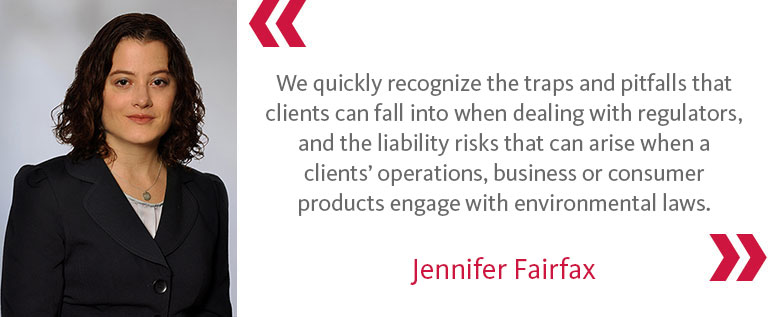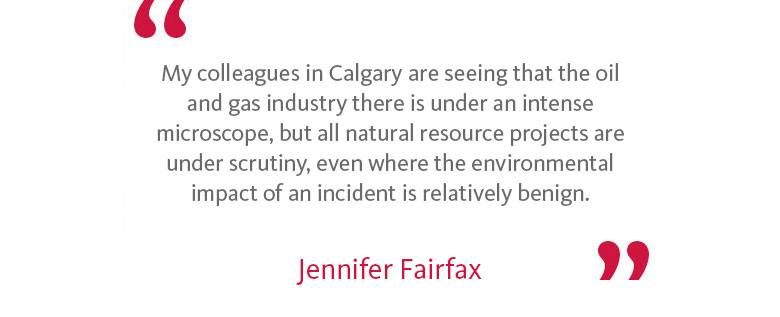Author(s):
Jennifer Fairfax
Oct 7, 2022
Jennifer Fairfax is Chair of Osler’s Environmental Disputes, Investigations and Enforcement practice. Working together with Osler’s national team of experts, she brings a depth of experience and expertise to help clients navigate the increasingly complex world of regulatory enforcement.

Q: You have a dynamic practice within the integrated Regulatory, Indigenous and Environmental group at Osler. Why were you drawn to this area of law?
Jennifer: I started at Osler as a litigator, gaining expertise in, among other areas, corporate, construction and infrastructure and project-based litigation. In my first few years of practice, my interest was piqued in regulatory/environmental law, partly as a result of my clerkship at the Federal Court of Appeal for Justice J. Edgar Sexton (who once Chaired Osler’s litigation practice), but more because of the multi-faceted areas of the practice. One day’s work can range from providing compliance advice, conducting transactional due diligence, dealing with regulatory inspections, inquiries and investigations, defending prosecutions, appealing orders, and leading environmental court actions. But what maintained my interest was the people who practice it – our amazing team at Osler and the strength of the collaborative environmental bar in Canada – and learning to embrace the constant change that comes with practicing environmental law. Regulatory, environmental and Indigenous law is a complex, intellectually challenging and ever-changing area. Laws shift – they are frequently amended or sometimes repealed in totality, sometimes depending on the provincial or federal political party in power. Every day clients are presented with unique problems, and helping our clients successfully navigate those problems is very rewarding.
Q: How does your background in this area of law work to serve clients well?
Jennifer: With team members based in Alberta, but also licensed to practice in the Northwest Territories, British Columbia, and our strong teams in Ontario and in our Montréal office covering Québec, we have a national, seamless practice that can cover clients with facilities and operations across Canada. We can leverage each other’s skill sets, providing real-time, practical and consistent advice to clients who need urgent help handling inquiries from regulators and incident response. As litigators with expertise in environmental laws – we don’t dabble! We quickly recognize the traps and pitfalls that clients can fall into when dealing with regulators, and the liability risks that can arise when a clients’ operations, business or consumer products engage with environmental laws.
Q: What are the major challenges right now for the clients you’re dealing with?
Jennifer: We have seen, both federally and provincially, a growing trend of increased or more frequent facility inspections and inquiries, a greater tendency of regulators to refer “paperwork” and minor non-compliances for investigation and possible charges (even if there has been no negative impact to the environment), and a general push by regulators to pursue higher fines.
In Ontario, we also have an environmental regulator who is not shy about naming directors and officers personally in remediation orders, since directors and officers of corporations can be liable under our Environmental Protection Act as persons “in management or control.” Directors and officers also have an explicit duty in many environmental laws in Canada to ensure that corporations take all reasonable care to prevent the corporation from committing certain types of offences.
As a result, clients are dealing with high-pressured and complex situations, trying to handle, in real-time, unanticipated inquiries by regulators, demanding responses on an urgent basis, often where it is not clear whether a response is “mandatory” or “voluntary”. This type of regulatory oversight, where clients feel the pressure to maintain a good relationship with the regulator, can result in inadvertent (and unhelpful) admissions. Environmental, health and safety incidents also trigger self-reporting obligations that sometimes, despite best efforts, can be “missed.” On top of this, we have a confusing patchwork of often nearly-unreadable environmental regulations (municipal, provincial and federal), which can be difficult for even sophisticated clients with strong EHS (Environmental, Health and Safey) teams to figure out.
In addition, our team is seeing greater stakeholder involvement when environmental incidents occur. Our Indigenous law experts, including Richard King and Sander Duncanson, are seeing clients having to not only deal with the regulator in response to an incident, but also having obligations under impact benefit agreements (IBA) with Indigenous communities, or otherwise managing requests from local Indigenous communities for immediate information regarding an incident On top of that, clients often have to balance public relations obligations with the legal response to the regulator, which sometimes are at odds. Legal counsel need multi-disciplinary teams that are able to adapt and provide a range of options that helps the client balance all these considerations.
Q: How are the penalties becoming more severe for environmental offences in Canada?
Jennifer: The penalties are both financial and reputational. For instance, in 2012, the federal Government passed the Environmental Enforcement Act (EEA), which made a concerted effort to significantly increase the fine levels for environmental offences across various pieces of federal legislation. The EEA also codified in certain federal environmental laws sentencing principles for regulatory offences, modelled after Canada’s Criminal Code – focusing on deterrence, denunciation, restoration and recovery, and the polluter-pays principle.
The fine increases were phased in over a period of time, and now the Canadian Environmental Protection Act, the Migratory Birds Convention Act, and other federal laws, carry very high statutory maximum fines, even for first convictions, of up to $6 million for corporations. The Fisheries Act and many provincial environmental laws carry similarly high statutory mandatory minimum and maximum fines. These fines can technically apply per day that an offence continues and are structured so that with “second” and “subsequent” offences, the corporation is automatically in a higher fine bracket. Fines can easily get ratcheted up, at the discretion of the prosecutor and courts. In the last few years, we have seen provincial and federal prosecutors with the Department of Justice embracing these higher fine levels.
A few examples include the Volkswagen fine levied in January 2020 at $196.5 million for multiple counts under the Canadian Environmental Protection Act vehicle emission regulations, and the $60 million fine levied against Teck Coal Limited in 2021 for charges under the Fisheries Act. Even the University of British Columbia was hit with a fine over $1 million in 2021 under the Fisheries Act for a release of ammonia from its refrigeration system, that was under repair. In 2021, Environment and Climate Change Canada released its Report on the Review of the Federal Environmental Fines and Sentencing Regime – 10 years later. As this report notes, while there is great variation in the fines imposed, the highest fines imposed by courts are much higher today (e.g., in the millions) than the highest fine imposed under environmental laws prior to the adoption of the EEA (which were generally around only $100,000).
ECCC’s 2021 report also points out that the environment – climate change, biodiversity, species at risk, and nature conservation – was identified in public opinion polls in 2021 by 96% of Canadians as being “somewhat important”, or by 57% of Canadians as being “very important”, to their well-being. The environment is top of mind for the public, and hence needs to be top of mind for corporations as well.
A conviction for an environmental offence gains press attention and can have a negative impact on a corporation’s ESG report card. Environmental regulators (like the Ontario Ministry of the Environment and Alberta’s Energy Regulator and Ministry of the Environment) publish press releases outlining the key facts and penalties for each conviction. ECCC also maintains a publicly accessible “Environmental Offender Registry”. A conviction can then impact a corporation’s reputation.

Q: Are there specific sectors or industries that are being specifically targeted or at risk of scrutiny by regulators?
Jennifer: My colleagues in Calgary are seeing that the oil and gas industry there is under an intense microscope, but all natural resource projects are under scrutiny, even where the environmental impact of an incident is relatively benign. In addition, the mining industry in Ontario appears to be under more scrutiny, both by the Ministry of the Environment, Conservation and Parks, and the Ministry of Northern Development, Mines, Natural Resources and Forestry. Ontario’s Ministry of the Environment also seems hyper focused right now on any releases to water, sewage works, storm water management, and waste management, transportation and disposal, particularly if waste is being transported without the proper permits.
Q: What are the proactive measures corporations can take to help avoid some of the enforcement issues you are seeing regulators and government bodies coming forward with right now?
Jennifer: One key step is to be ready from the “get go” – when the environmental enforcement officers come “knocking”. For instance, our Osler Update on Best practices in environmental incident response, provides a checklist of proactive measures and tips to help avoid the enforcement issues we are seeing.
Another good step is to give your facilities and operations a hard look, such as through an internal investigation or audit under legal privilege with the advice of your in-house and external legal counsel, to assess the company’s compliance with environmental laws and its permits. This could be a “gap analysis” or a “red flag” analysis, to see where problem areas may lie, either in the company’s environmental management system, policies or procedures, or in employees’ understanding of those policies or procedures, permit conditions or incident response coordination, and proactively make improvements, where they may be needed. Even contracts with contractors and subcontractors merit a close review, to ensure that provisions requiring compliance with environmental laws are robust enough, given a company can still be liable for environmental regulatory obligations that get delegated to third parties.
Q: Please explain how the practice group is equipped to manage the various needs clients have in this area of enforcement and prosecution?
Jennifer: This area requires a skill set with an aptitude in both “hard law” and “soft law” – strong practical and business-minded insights, a strong understanding of a complex web of overlapping provincial and federal laws, the ability to communicate effectively and credibly with regulators, and negotiation and advocacy skills to be used with opposing parties, regulators, before tribunals and the courts, to resolve environmental disputes.
We offer a wide array of expertise to manage clients’ needs, such as working proactively with clients, advising on complex regulations, permit compliance, and conducting environmental “red flag” and management system reviews. We can also assist in conducting due diligence on environmental contractors, subcontractors, and consultants, including ensuring those hired have appropriate permits/approvals in place. Our work also includes helping clients respond to inspectors and investigators’ questions, to avoid inadvertent admissions or prejudicial communications. We also defend clients in environmental prosecutions and can negotiate with regulators, advocating a clients’ position on regulatory interpretation and compliance.